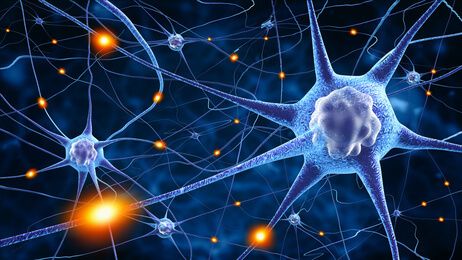
Max Planck Neuroscience
@mpneuro.bsky.social
Discoveries about the brain from around the Max Planck Society.
Researchers at @mpibrain.bsky.social have created a vividly detailed atlas of the mouse hippocampus, combining RNA & protein data to pinpoint more than 27,000 molecules at single-synapse resolution: bit.ly/3WgAaui

November 4, 2025 at 9:37 PM
Researchers at @mpibrain.bsky.social have created a vividly detailed atlas of the mouse hippocampus, combining RNA & protein data to pinpoint more than 27,000 molecules at single-synapse resolution: bit.ly/3WgAaui
A 5-year project at @mpicybernetics.bsky.social is using fMRI to understand shared mechanisms and the role of dopamine in hasty or delayed decision-making in schizophrenia and OCD.
Explore the study: bit.ly/49juJSR
Explore the study: bit.ly/49juJSR

October 29, 2025 at 6:28 PM
A 5-year project at @mpicybernetics.bsky.social is using fMRI to understand shared mechanisms and the role of dopamine in hasty or delayed decision-making in schizophrenia and OCD.
Explore the study: bit.ly/49juJSR
Explore the study: bit.ly/49juJSR
New discovery: Researchers at LMU University Hospital of Psychiatry, IMPRS-TP & Max Planck Institute of Psychiatry found a mechanism for schizophrenia cognitive symptoms.
Explore early maturation in oligodendrocytes, which may become a treatment target: bit.ly/48gHXzd
Explore early maturation in oligodendrocytes, which may become a treatment target: bit.ly/48gHXzd

October 14, 2025 at 6:23 PM
New discovery: Researchers at LMU University Hospital of Psychiatry, IMPRS-TP & Max Planck Institute of Psychiatry found a mechanism for schizophrenia cognitive symptoms.
Explore early maturation in oligodendrocytes, which may become a treatment target: bit.ly/48gHXzd
Explore early maturation in oligodendrocytes, which may become a treatment target: bit.ly/48gHXzd
Researchers at @mpibrain.bsky.social found that ribosomes may be able to be assembled on-demand & where needed. This discovery could influence future research on synaptic plasticity, memory formation & protein-associated neurological disorders. Explore the study: bit.ly/3VRVbuU

October 7, 2025 at 6:15 PM
Researchers at @mpibrain.bsky.social found that ribosomes may be able to be assembled on-demand & where needed. This discovery could influence future research on synaptic plasticity, memory formation & protein-associated neurological disorders. Explore the study: bit.ly/3VRVbuU
Researchers from @mpi-psychiatry.bsky.social, Helmholtz Munich & the University of Sydney have identified shared biological mechanisms in 3 psychiatric disorders, including disruptions in circadian rhythm & dopamine levels. Explore the research: bit.ly/4mjec4e

September 30, 2025 at 1:23 PM
Researchers from @mpi-psychiatry.bsky.social, Helmholtz Munich & the University of Sydney have identified shared biological mechanisms in 3 psychiatric disorders, including disruptions in circadian rhythm & dopamine levels. Explore the research: bit.ly/4mjec4e
Lean mice that smell food before eating feel full; obese mice don’t. Why?
Research from @mpi-metabolism.bsky.social found a link between olfactory bulb nerve cells and the brain area that triggers satiety.
This could shed light on how humans react to smelling food: bit.ly/4nX4XZI
Research from @mpi-metabolism.bsky.social found a link between olfactory bulb nerve cells and the brain area that triggers satiety.
This could shed light on how humans react to smelling food: bit.ly/4nX4XZI

August 28, 2025 at 5:00 PM
Lean mice that smell food before eating feel full; obese mice don’t. Why?
Research from @mpi-metabolism.bsky.social found a link between olfactory bulb nerve cells and the brain area that triggers satiety.
This could shed light on how humans react to smelling food: bit.ly/4nX4XZI
Research from @mpi-metabolism.bsky.social found a link between olfactory bulb nerve cells and the brain area that triggers satiety.
This could shed light on how humans react to smelling food: bit.ly/4nX4XZI
How do rats sense their world? Through their whiskers! Researchers at @mpinb.mpg.de found that whisker movement is controlled by surprisingly diverse brain areas, including sensory and motor regions working together. Explore the research: bit.ly/3TMNbuh

August 21, 2025 at 2:06 PM
How do rats sense their world? Through their whiskers! Researchers at @mpinb.mpg.de found that whisker movement is controlled by surprisingly diverse brain areas, including sensory and motor regions working together. Explore the research: bit.ly/3TMNbuh
Research from @mpiforbi.bsky.social in @natneuro.nature.com shows that later-born inhibitory neurons mature more quickly in the developing brain. This allows them to synchronize with earlier-born neurons and maintain balanced networks. bit.ly/3TIghem

August 18, 2025 at 6:30 PM
Research from @mpiforbi.bsky.social in @natneuro.nature.com shows that later-born inhibitory neurons mature more quickly in the developing brain. This allows them to synchronize with earlier-born neurons and maintain balanced networks. bit.ly/3TIghem
Research from @mpfneuro.bsky.social shows a connection between lack of the gene PTEN in specific neurons in the amygdala and rewiring of anxiety and fear circuits. This hyper-local brain circuitry discovery may lead to future targeted therapies: bit.ly/4nWSa9z

August 7, 2025 at 12:37 PM
Research from @mpfneuro.bsky.social shows a connection between lack of the gene PTEN in specific neurons in the amygdala and rewiring of anxiety and fear circuits. This hyper-local brain circuitry discovery may lead to future targeted therapies: bit.ly/4nWSa9z
Researchers at @mpi-metabolism.bsky.social have identified a group of nerve cells in the brains of mice that have an outsized influence on appetite and weight gain. Humans have similar nerve cells, and this discovery may lead to new obesity treatments. Learn more. bit.ly/4fHjpS1

August 5, 2025 at 1:56 PM
Researchers at @mpi-metabolism.bsky.social have identified a group of nerve cells in the brains of mice that have an outsized influence on appetite and weight gain. Humans have similar nerve cells, and this discovery may lead to new obesity treatments. Learn more. bit.ly/4fHjpS1
LLMs’ creative processes are similar to humans’, favoring either a flexible or persistent approach to ideation. See why
@mpicybernetics.bsky.social suggests choosing an LLM that finds ideas in the same way as a particular human can improve collaboration. maxplanckneuroscience.org/almost-like-...
@mpicybernetics.bsky.social suggests choosing an LLM that finds ideas in the same way as a particular human can improve collaboration. maxplanckneuroscience.org/almost-like-...

July 29, 2025 at 1:29 PM
LLMs’ creative processes are similar to humans’, favoring either a flexible or persistent approach to ideation. See why
@mpicybernetics.bsky.social suggests choosing an LLM that finds ideas in the same way as a particular human can improve collaboration. maxplanckneuroscience.org/almost-like-...
@mpicybernetics.bsky.social suggests choosing an LLM that finds ideas in the same way as a particular human can improve collaboration. maxplanckneuroscience.org/almost-like-...
For the first time, researchers from @mpi-psychiatry.bsky.social have shown how environmental stressors alter neuronal balance before birth. Explore the research: maxplanckneuroscience.org/stress-alter...

July 22, 2025 at 12:58 PM
For the first time, researchers from @mpi-psychiatry.bsky.social have shown how environmental stressors alter neuronal balance before birth. Explore the research: maxplanckneuroscience.org/stress-alter...
Despite the trillions of synapses in the brain, there is sparse connectivity between neurons. This may be a feature, not a flaw, per new research at @mpinb.mpg.de.
A study finds that “sparse connectivity” of neurons may contribute to more efficient info-processing in the brain: bit.ly/4kO1TMY
A study finds that “sparse connectivity” of neurons may contribute to more efficient info-processing in the brain: bit.ly/4kO1TMY

July 15, 2025 at 1:44 PM
Despite the trillions of synapses in the brain, there is sparse connectivity between neurons. This may be a feature, not a flaw, per new research at @mpinb.mpg.de.
A study finds that “sparse connectivity” of neurons may contribute to more efficient info-processing in the brain: bit.ly/4kO1TMY
A study finds that “sparse connectivity” of neurons may contribute to more efficient info-processing in the brain: bit.ly/4kO1TMY
Researchers from @bmc-lmu.bsky.social and @mpi-psychiatry.bsky.social have found why “misplaced” neurons in the brain can lead to periventricular heterotopia. Explore how these insights into disrupted brain wiring could lead to new treatments. maxplanckneuroscience.org/misplaced-ne...

July 8, 2025 at 12:50 PM
Researchers from @bmc-lmu.bsky.social and @mpi-psychiatry.bsky.social have found why “misplaced” neurons in the brain can lead to periventricular heterotopia. Explore how these insights into disrupted brain wiring could lead to new treatments. maxplanckneuroscience.org/misplaced-ne...
How do our brains predict what’s next? Research from the Max Planck Institute for Empirical Aesthetics, Ernst Strüngmann Institute for Neuroscience & @goetheuni.bsky.social, published in @natcomms.nature.com, explores how brain rhythms influence our navigation of time: bit.ly/3GpD8rU

July 1, 2025 at 1:19 PM
How do our brains predict what’s next? Research from the Max Planck Institute for Empirical Aesthetics, Ernst Strüngmann Institute for Neuroscience & @goetheuni.bsky.social, published in @natcomms.nature.com, explores how brain rhythms influence our navigation of time: bit.ly/3GpD8rU
How does the brain know when it’s time to rest? Explore new research from the Max Planck Institute for Neurobiology of Behavior in Bonn, in which advanced imaging reveals the role of glial cells in regulating the wake/rest cycles and energy balance of fruit files. bit.ly/4kM90pd

June 17, 2025 at 5:50 PM
How does the brain know when it’s time to rest? Explore new research from the Max Planck Institute for Neurobiology of Behavior in Bonn, in which advanced imaging reveals the role of glial cells in regulating the wake/rest cycles and energy balance of fruit files. bit.ly/4kM90pd
What is consciousness? An international research consortium led by Max Planck Institute for Empirical Aesthetics set out to test two leading theories.
Their groundbreaking collaborative effort yields a new way to study complex scientific questions: maxplanckneuroscience.org/rethinking-c...
Their groundbreaking collaborative effort yields a new way to study complex scientific questions: maxplanckneuroscience.org/rethinking-c...

June 10, 2025 at 12:50 PM
What is consciousness? An international research consortium led by Max Planck Institute for Empirical Aesthetics set out to test two leading theories.
Their groundbreaking collaborative effort yields a new way to study complex scientific questions: maxplanckneuroscience.org/rethinking-c...
Their groundbreaking collaborative effort yields a new way to study complex scientific questions: maxplanckneuroscience.org/rethinking-c...
New research from @mpi-psychiatry.bsky.social shows early life stress may contribute to resiliency in female mice, thanks to a specific protein in the brain neurons. This may lead to improved mental health treatments: maxplanckneuroscience.org/early-life-s...

June 3, 2025 at 6:03 PM
New research from @mpi-psychiatry.bsky.social shows early life stress may contribute to resiliency in female mice, thanks to a specific protein in the brain neurons. This may lead to improved mental health treatments: maxplanckneuroscience.org/early-life-s...
For the first time, @mpiforbi.bsky.social researchers found functional neuron columns in the visual cortex of mice. The eye-specific neurons form clusters, like in the brains of larger animals. See how this deepens our understanding of fundamental brain organization: bit.ly/4iRPGpr

May 12, 2025 at 12:58 PM
For the first time, @mpiforbi.bsky.social researchers found functional neuron columns in the visual cortex of mice. The eye-specific neurons form clusters, like in the brains of larger animals. See how this deepens our understanding of fundamental brain organization: bit.ly/4iRPGpr
New research from @mpiforbi.bsky.social, University of Regensburg, & Stanford identifies specific neurons that regulate thirst & hunger in mice. See how this deepens our understanding of how the brain translates nutritional needs into action: bit.ly/4iAfOF1

May 5, 2025 at 1:56 PM
New research from @mpiforbi.bsky.social, University of Regensburg, & Stanford identifies specific neurons that regulate thirst & hunger in mice. See how this deepens our understanding of how the brain translates nutritional needs into action: bit.ly/4iAfOF1
New research from @mpiforbi.bsky.social on European jackdaws reveals that when sleep deprived, they prioritize deep sleep, even at the cost of vigilance.
This highlights the crucial role of deep sleep. Explore the research, published in @currentbiology.bsky.social: bit.ly/3EFeIKc
This highlights the crucial role of deep sleep. Explore the research, published in @currentbiology.bsky.social: bit.ly/3EFeIKc

April 28, 2025 at 4:01 PM
New research from @mpiforbi.bsky.social on European jackdaws reveals that when sleep deprived, they prioritize deep sleep, even at the cost of vigilance.
This highlights the crucial role of deep sleep. Explore the research, published in @currentbiology.bsky.social: bit.ly/3EFeIKc
This highlights the crucial role of deep sleep. Explore the research, published in @currentbiology.bsky.social: bit.ly/3EFeIKc
Reposted by Max Planck Neuroscience
Happy birthday, Max Planck! 🎂The physicist, pianist, #NobelPrize winner, #quantum trailblazer & timeless thinker was born #OTD 1858 in Kiel: his discoveries in the field of #physics forever changed how we understand energy & matter!🎉

April 23, 2025 at 12:13 PM
Happy birthday, Max Planck! 🎂The physicist, pianist, #NobelPrize winner, #quantum trailblazer & timeless thinker was born #OTD 1858 in Kiel: his discoveries in the field of #physics forever changed how we understand energy & matter!🎉

